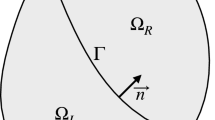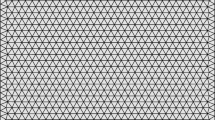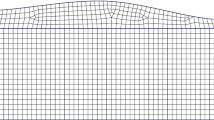Abstract
We present a hybrid continuous and discontinuous Galerkin spectral element approximation that leverages the advantages of each approach. The continuous Galerkin approximation is used on interior element faces where the equation properties are continuous. A discontinuous Galerkin approximation is used at physical boundaries and if there is a jump in properties at a face. The approximation uses a split form of the equations and two-point fluxes to ensure stability for unstructured quadrilateral/hexahedral meshes with curved elements. The approximation is also conservative and constant state preserving on such meshes. Spectral accuracy is obtained for all examples, which include wave scattering at a discontinuous medium boundary.











Similar content being viewed by others
Availability of data and materials
The paper includes the proofs of stability, constant state preservation and conservation, implementation notes, and the parameters needed to reproduce the results.
References
Abgrall, R., Nordström, J., Öffner, P., Tokareva, S.: Analysis of the SBP-SAT stabilization for finite element methods part I: linear problems. J. Sci. Comput. 85(2), 43 (2020)
Ainsworth, M.: Dispersive and dissipative behaviour of high order discontinuous Galerkin finite element methods. J. Comput. Phys. 198, 106–130 (2004)
Angulo, L.D., Alvarez, J., Teixeira, F.L., Pantoja, M.F., Garcia, S.G.: A nodal continuous-discontinuous Galerkin time-domain method for Maxwell’s equations. IEEE Trans. Microw. Theory Tech. 63(10), 3081–3093 (2015)
Cantwell, C.D., Moxey, D., Comerford, A., Bolis, A., Rocco, G., Mengaldo, G., De Grazia, D., Yakovlev, S., Lombard, J.-E., Ekelschot, D., Jordi, B., Xu, H., Mohamied, Y., Eskilsson, C., Nelson, B., Vos, P., Biotto, C., Kirby, R.M., Sherwin, S.J.: Nektar++: an open-source spectral/hp element framework. Comput. Phys. Commun. 192, 205–219 (2015)
Canuto, C., Hussaini, M.Y., Quarteroni, A., Zang, T.A.: Spectral Methods: Fundamentals in Single Domains. Springer, Berlin (2006)
Chen, T., Shu, C.-W.: Entropy stable high order discontinuous Galerkin methods with suitable quadrature rules for hyperbolic conservation laws. J. Comput. Phys. 345, 427–461 (2017)
Cohen, G., Ferrieres, X., Pernet, S.: A spatial high-order hexahedral discontinuous Galerkin method to solve Maxwell’s equations in time domain. J. Comput. Phys. 217(2), 340–363 (2006)
Dawson, C., Proft, J.: Coupled discontinuous and continuous Galerkin finite element methods for the depth-integrated shallow water equations. Comput. Methods Appl. Mech. Eng. 193(3), 289–318 (2004)
Deng, S.Z., Cai, W., Astratov, V.N.: Numerical study of light propagation via whispering gallery modes in microcylinder coupled resonator optical waveguides. Opt. Express 12(26), 6468–6480 (2004)
Gassner, G., Kopriva, D.A.: A comparison of the dispersion and dissipation errors of Gauss and Gauss–Lobatto discontinuous Galerkin spectral element methods. SIAM J. Sci. Comput. 33, 2560–2579 (2011)
Gassner, G.J., Winters, A.R., Hindenlang, F.J., Kopriva, D.A.: The BR1 scheme is stable for the compressible Navier–Stokes equations. J. Sci. Comput. (2018)
Ghasemi, F., Nordström, J.: Coupling requirements for multiphysics problems posed on two domains. SIAM J. Numer. Anal. 55(6), 2885–2904 (2017)
Hesthaven, J.S., Warburton, T.: Nodal high-order methods on unstructured grids. I. Time-domain solution of Maxwell’s equations. J. Comput. Phys. 181, 186–221 (2002)
Hindenlang, F.J., Gassner, G.J.: On the order reduction of entropy stable DGSEM for the compressible Euler equations (2019)
Hu, F.Q., Hussaini, M.Y., Rasetarinera, P.: An analysis of the discontinuous Galerkin method for wave propagation problems. J. Comput. Phys. 151(2), 921–946 (1999)
Kelly, J.F., Giraldo, F.X.: Continuous and discontinuous Galerkin methods for a scalable three-dimensional nonhydrostatic atmospheric model: Limited-area mode. J. Comput. Phys. 231, 7988–8008 (2012)
Kopriva, D.A.: Metric identities and the discontinuous spectral element method on curvilinear meshes. J. Sci. Comput. 26(3), 301–327 (2006)
Kopriva, D.A., Gassner, G.: An energy stable discontinuous Galerkin spectral element discretization for variable coefficient advection problems. SIAM J. Sci. Comput. 36(4), A2076–A2099 (2014)
Kopriva, D.A., Woodruff, S.L., Hussaini, M.Y.: Discontinuous spectral element approximation of Maxwell’s Equations. In: Cockburn, B., Karniadakis, G., Shu, C.-W., (eds) Proceedings of the International Symposium on Discontinuous Galerkin Methods, pp. 355–361, Springer, New York (2000)
Kopriva David, A.: Implementing Spectral Methods for Partial Differential Equations. Scientific Computation. Springer (2009)
Kopriva, D.A.: A polynomial spectral calculus for analysis of DG spectral element methods. In: Bittencourt, M.L., Dumont, N.A., Hesthaven, J.S.,(eds) Spectral and High Order Methods for Partial Differential Equations ICOSAHOM 2016, pp. 21–40. Springer, Cham (2017)
Kopriva, D.A., Gassner, G.J.: Geometry effects in nodal discontinuous Galerkin methods on curved elements that are provably stable. Appl. Math. Comput., 272, Part 2:274 – 290 (2016)
Kopriva, D.A., Gassner, G.J., Nordström, J.: Stability of discontinuous Galerkin spectral element schemes for wave propagation when the coefficient matrices have jumps. Journal of Scientific Computing 88(1), pp. 1–23 (2021). arXiv: 2011.11746 (2020)
La Cognata, C., Nordström, J.: Well-posedness, stability and conservation for a discontinuous interface problem. BIT Numer. Math. 56(2), 681–704 (2016)
Mohammadian, A.H., Shankar, V., Hall, W.F.: Application of time-domain finite-volume method to some radiation problems in 2-dimensions and 3-dimensions. IEEE Trans. Magn. 27(5):3841–3844 (1991)
Nordström, J.: A roadmap to well posed and stable problems in computational physics. J. Sci. Comput. 71, 365–385 (2017)
Pind, F., Engsig-Karup, A., Jeong, C.-H., Hesthaven, J., Mejling, M., Strømann-Andersen, J.: Time domain room acoustic simulations using a spectral element method. J. Acoust. Soc. Am. 145, 05 (2019)
Rasetarinera, P., Kopriva, D.A., Hussaini, M.Y.: Discontinuous spectral element solution of acoustic radiation from thin airfoils. AIAA J. 39(11), 2070–2075 (2001)
van Lith, B.S.: Principles of computational illumination optics. Technische Universiteit Eindhoven (2017) (PhD thesis)
Warburton, T.: Application of the discontinuous Galerkin method to Maxwell’s Equations using unstructured polymorphic \(hp\)-finite elements. In: Cockburn, B., Karniadakis, G., Shu, C.-W., (eds) Proceedings of the International Symposium on Discontinuous Galerkin Methods. Springer, New York (2000)
Wilcox, L.C., Stadler, G., Burstedde, C., Ghattas, O.: A high-order discontinuous Galerkin method for wave propagation through coupled elastic-acoustic media. J. Comput. Phys. 229(24), 9373–9396 (2010)
Williamson, J.H.: Low-storage Runge–Kutta schemes. J. Comput. Phys. 35, 48–56 (1980)
Winters, A.R., Kopriva, D.A., Gassner, G.J., Hindenlang, F.: Construction of Modern Robust Nodal Discontinuous Galerkin Spectral Element Methods for the Compressible Navier–Stokes Equations, pp. 117–196. Springer, Cham (2021)
Acknowledgements
This work was supported by a grant from the Simons Foundation (#426393, David Kopriva). Gregor Gassner thanks the Klaus-Tschira Stiftung and the European Research Council for funding through the ERC Starting Grant “An Exascale aware and Un-crashable Space-Time-Adaptive Discontinuous Spectral Element Solver for Non-Linear Conservation Laws” (EXTREME, Project No. 71448).
Funding
This work was supported by a grant from the Simons Foundation (#426393, David Kopriva), the Klaus-Tschira Stiftung and the European Research Council for funding through the ERC Starting Grant “An Exascale aware and Un-crashable Space-Time-Adaptive Discontinuous Spectral Element Solver for Non-Linear Conservation Laws” (EXTREME, Project No. 71448) (Gregor Gassner).
Author information
Authors and Affiliations
Corresponding author
Ethics declarations
Conflict of interest
The authors have no relevant financial or non-financial interests to disclose.
Code availability
The code used to generate the results is not available.
Additional information
Publisher's Note
Springer Nature remains neutral with regard to jurisdictional claims in published maps and institutional affiliations.
Proof of Physical Boundary Dissipation
Proof of Physical Boundary Dissipation
We show that (93) holds. As for the continuous problem, let  be the normal coefficient matrix. The physical boundary can be viewed as being between two identical media so the numerical flux reduces to the standard upwind flux (75),
be the normal coefficient matrix. The physical boundary can be viewed as being between two identical media so the numerical flux reduces to the standard upwind flux (75),
Then

Since \(\mathbf{U}^{s}\) is the value taken from the interior, i.e. \(\mathbf{U}_{L}\),

But \(\left| {A}^{s}\right| = {A}^{s,+}- {A}^{s,-}\), so

Also, \( {A}^{s,-} = -\left| {A}^{s,-}\right| \), so

The last two terms are non-negative.
To simplify the next few steps, we define \(\bar{\mathbf{U}} \equiv \sqrt{\left| {A}^{s,-}\right| }\mathbf{U} \). Then

Completing the square,

Replacing the external state \(\bar{\mathbf{U}}_{R}\) with a boundary condition \(\bar{\mathbf{g}}\),

Therefore,

When we return to the original variables, we get the desired result, (93).
Rights and permissions
About this article
Cite this article
Kopriva, D.A., Gassner, G.J. A Split-form, Stable CG/DG-SEM for Wave Propagation Modeled by Linear Hyperbolic Systems. J Sci Comput 89, 2 (2021). https://doi.org/10.1007/s10915-021-01618-5
Received:
Revised:
Accepted:
Published:
DOI: https://doi.org/10.1007/s10915-021-01618-5




